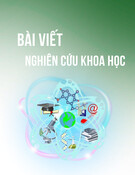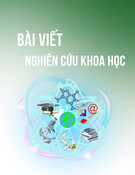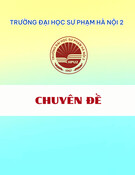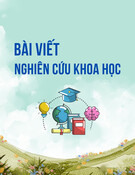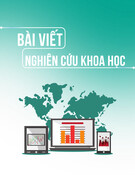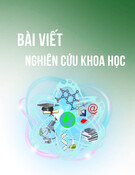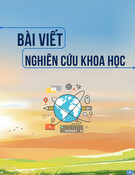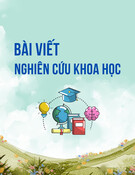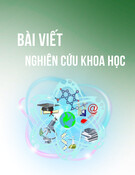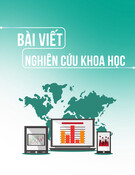
T
ẠP CHÍ KHOA HỌC
TRƯ
ỜNG ĐẠI HỌC SƯ PHẠM TP HỒ CHÍ MINH
Tập 21, Số 6 (2024): 1007-1018
HO CHI MINH CITY UNIVERSITY OF EDUCATION
JOURNAL OF SCIENCE
Vol. 21, No. 6 (2024): 1007-1018
ISSN:
2734-9918
Websit
e: https://journal.hcmue.edu.vn https://doi.org/10.54607/hcmue.js.21.6.4291(2024)
1007
Research Article1
DIGITAL EDUCATION INNOVATION IN VIETNAM:
LEADERSHIP AND CHANGE MANAGEMENT
IN HIGHER EDUCATION INSTITUTIONS
Nguyen Lan Phuong
Department of Education, Nguyen Tat Thanh University, Vietnam
Corresponding author: Nguyen Lan Phuong – Email: nlphuong@ntt.edu.vn
Received: May 23, 2024; Revised: June 17, 2024; Accepted: June 22, 2024
TÓM TẮT
This study investigates the interaction between knowledge transfer, change management, and
leadership in promoting innovation within the digital education ecosystem of Vietnamese
universities. As rapid technological advancements challenge these institutions to integrate
innovations into their educational frameworks, the research explores how these three factors
influence the adoption of digital education innovations, thereby shaping the teaching and learning
environment. The study reviews related literature on digital education ecosystems, educational
leadership, innovation, and change management using Google Scholar. Key concepts examined
include knowledge transfer, change management, and innovative educational leadership. The
effectiveness of universities' change management strategies is evaluated, with an emphasis on
leadership, organizational culture, and stakeholder engagement. Findings underscore the
significance of successful knowledge transfer and robust change management for digital innovation
while identifying challenges such as resistance to change and limited technological infrastructure.
The study concludes with recommendations for supporting knowledge transfer, implementing
comprehensive change management strategies, and investing in digital infrastructure and faculty
development.
Keywords: change management; educational leadership; innovation; knowledge transfer
1. Introduction
Learning methodologies are changing as a result of the rapid advancement of information
technology, the extensive digitization of the educational system, and the paradigm shift in that
system. Integrated learning techniques are made possible by the quick changes in educational
trends and the ongoing creation of new ICTs. The current educational system needs to change
in response to the fourth industrial revolution, which brought cyber-physical systems and
artificial intelligence into everyday life. The majority of graduates who enter the workforce will
work in jobs that do not yet exist. Under these circumstances, skills become essential and need
to be developed in accordance with Industry 4.0.
Cite this article as: Nguyen Lan Phuong (2024). Digital education innovation in Vietnam: Leadership and change
management in school buildings. Ho Chi Minh City University of Education Journal of Science, 21(6), 1007-1018.

HCMUE Journal of Science
Nguyen Lan Phuong
1008
The World Economic Forum 2019 Platform launched the Education 4.0 forum, which
suggested systemic changes to the creation and application of promising models of high-quality
education. The forum aimed to shape the future of the new economy and society following the
demands of the fourth industrial revolution. "Global citizenship skills, innovation and creativity
skills; technology skills; interpersonal skills; personalized and self-paced learning; accessible
and inclusive learning; problem-based and collaborative learning; lifelong and student-driven
learning" are the eight key findings that the World Economic Forum 2019 report identified for
forming education 4.0 models (World Economic Forum, 2020).
Economic progress in the future is primarily dependent on having skilled engineers,
whose education ought to start in secondary school. After that, it ought to carry on in colleges
and universities by actively promoting STEM education. It is possible to view STEM education
as a universal framework for excellently preparing students and teachers for careers in Industry
4.0. The following tasks are implemented by STEM education (ERIC, 2018).
The importance of the digital transformation of higher education is growing,
particularly in the context of Vietnamese institutions, where integrating technology into
teaching methods is viewed as a tactical tool for improving administrative processes and
learning environments. However, the interaction of leadership in school buildings,
information transfer, and change management is critical to the success of such programs.
This essay aims to investigate how these components work together to promote innovation
in Vietnam's digital education environment (Do et al., 2023).
This study aims to clarify how knowledge transfer, change management, and
leadership can act as catalysts for innovative practices in higher education through a
thorough review of research and empirical studies, including the work of Tang and Nguyen
(2020), which highlights the critical role of leadership in educational reform. This research
contributes to a larger knowledge of how institutions can navigate and survive in the era of
digital education by emphasizing individual cases and tactics that have produced positive
outcomes in Vietnamese universities.
2. Literature Review
2.1. Innovation in the Digital Education Ecosystem
Besides the organizational structure and facilities serving traditional training and
research activities, the innovation university ecosystem needs to be much more expanded in
both structure and function. First, interdisciplinary research centers need to be established,
operating through projects aimed at transferring knowledge and technology to businesses.
Additionally, creative spaces and startup support centers must be created for lecturers,
students, and the startup community to collaborate, design, build, and develop new products.
Alongside the business incubator and startup center, an intellectual property development
center is essential for universities committed to adding value to society. The ecological
significance of higher education facilities is widely recognized and can be implemented in
various models, but the most fundamental and specific aspect is the creation of an open,
friendly, and modern university campus.

HCMUE Journal of Science
Vol. 21, No. 6 (2024): 1007-1018
1009
Within this ecosystem, universities should forge strong connections with incubators,
science parks, and other external partners, creating opportunities for the exchange of
knowledge, ideas, and design thinking. This integration helps innovation-oriented
universities not only gain additional material resources but also foster a free learning
environment that promotes creativity for all stakeholders. Finally, the ecological significance
of the university is directly linked to its sustainable development goals, as well as those of
the broader community. Universities are encouraged to adopt and implement the United
Nations' sustainable development goals, further emphasizing their commitment to societal
progress and environmental stewardship (Nguyen et al., 2022).
Interest in science and technology is growing, knowledge is applied in real-world
situations, critical thinking skills are developed, interdisciplinary connections are
strengthened through integrated learning, self-confidence is cultivated, cooperation skills are
developed, and innovation is introduced. Within the cutting-edge educational ecosystem,
new learning formats rely on digital technology that leverages artificial intelligence
techniques. The authors suggest utilizing appropriate information and communication
technology to modify the curriculum to the skills and abilities of the students. Artificial
intelligence, for instance, will be included in intelligent, interactive textbooks. Students can
measure their skills in real-time and receive recommendations for the direction of their
growth by using business games and business scenarios. To increase their drive to learn and
work creatively, students should make use of intelligent technologies built on knowledge
bases (Kovaliuk & Kobets, 2021).
2.2. Knowledge transfer
According to Albino et al. (2001), knowledge transfer is "the process through which one
unit (department, group, or division) is affected by the experience of another." It is obvious that
information is transferred from the holder(s) individual, group, team, or organization to the
recipient(s) individual, group, team, or organization. "The process whereby invention or
intellectual property from academic research is licensed or conveyed through use rights to a for-
profit entity and eventually commercialized" is what Friedman and Silberman (2003) described
as the knowledge transfer process. When experience in one area of an organization influences
another, either directly or indirectly, knowledge transfer occurs.
Over the past 25 years, there has been a significant growth in research on knowledge
transfer in organizations (Argote et al., 2022). Concerns about theory and practice have
contributed to the rise of this research focus (Argote, 2013). Practically speaking, advances
in information and communication technology made mass knowledge transfer possible.
Certain organizational structures, such as multinational corporations and multi-unit
businesses like chains or franchises, which have grown more common in recent years,
depend on knowledge transfer to be successful. To minimize any potential negative
consequences of the baby boom generation retiring, knowledge transfer becomes an issue.

HCMUE Journal of Science
Nguyen Lan Phuong
1010
2.3. Change management
Any continuous innovation endeavor must include change management (Rosenbaum et
al., 2018). All of the tasks required to accomplish change can be coordinated, approved,
monitored, and organized with the use of change management tools and processes (Cameron &
Green, 2015). Through constant creation, reuse, and dissemination, this iterative process
increases the value of information within the organization. The reasons behind the development
of this relationship between university and industry are varied (Thomas & Paul, 2019).
2.4. Educational Leadership in Universities
In the current context, defining an adequate concept of education leadership for
universities is among the first issues. The selected ontological and epistemological stance on
education, learning, and teaching contributes to part of the solution. The stance taken in this
research expands upon widely recognized theories regarding the degree of mental and
physical connectivity. This debate can be summed up as follows: does learning primarily
involve the mind and body as distinct entities, or does it also entail awareness of the
individual in context and their perception, emotions, and haptic connections?
The leadership of education in a university setting will necessitate the concurrent
coordination of important components of the education ecosystem, including the university's
education strategy, associated governance, and policy management of teaching, learning,
curriculum, and investment. Studies have indicated that a university's ability to attain its
goals for student learning is correlated with how closely these components are connected
(Bygstad et al., 2022). Therefore, rather than holding one person accountable for dictating
how the components behave, leadership is bringing many system components together to
cooperate toward a common goal. According to this idea, education leadership is more like
leading a multidisciplinary research lab, conducting an orchestra, or organizing creative and
inventive societies.
3. Method
A review of related literature on digital education ecosystems, education leadership,
innovation, knowledge transfer, and change management was employed in this paper
(Newson et al., 2018). The Internet and Google Scholar are the primary sources of secondary
documents. The search terms utilized include "knowledge transfer," "change management,"
"educational leadership," and "innovation." For digital education ecosystems, other terms
used are "overview" and "review." All websites surveyed are official university websites,
ensuring the reliability of the information collected. Numerous publications meeting the
aforementioned criteria were found by searching on Google Scholar using the terms
"knowledge transfer," "change management," "education leadership innovation," and
"digital education." The search yielded several thousand documents, which were then
filtered for relevance to the university education environment, focusing specifically on
innovation in learning ecosystems, educational leadership, and management, as well as the
integration of digital education and technology. The selected studies, encompassing
mechanisms of knowledge transfer, strategies for managing change, innovative leadership

HCMUE Journal of Science
Vol. 21, No. 6 (2024): 1007-1018
1011
practices, and digital education methods, serve as the foundation for comparing and
investigating a creative learning ecosystem model suitable for Vietnam, considering cultural
and institutional differences, and policy implications.
After applying the filtering criteria, the search results were narrowed down to a
manageable subset of high-quality publications. The final selection included studies on
knowledge transfer, focusing on mechanisms, strategies, and case studies in higher
education, emphasizing academia-industry collaboration and innovation. Change
management research highlighted how universities adopt new technologies and innovative
practices, addressing resistance to change, leadership strategies, and organizational culture.
Publications on education leadership innovation explored innovative leadership practices
through case studies, theoretical frameworks, and models promoting innovation.
Additionally, digital education studies covered the integration of digital tools and platforms,
online learning, digital pedagogy, and the effectiveness of these methods.
The selected studies were then analyzed for their applicability to the Vietnamese
educational context, considering how findings could be adapted to Vietnam's cultural and
institutional landscape. This included comparing global innovation ecosystem models with
the current state of Vietnamese education to identify potential areas for adaptation and
implementation. Additionally, the analysis provided insights on how policy-makers in
Vietnam can support the development of a creative learning ecosystem through strategic
interventions.
The refined set of publications provides a robust foundation for investigating a creative
learning ecosystem model suitable for Vietnam. By comparing and synthesizing insights from
these studies, the research aims to propose a model that addresses local needs while
incorporating global best practices in educational innovation. It is also covered on the websites
of numerous educational research organizations, including The Organisation for Economic Co-
operation and Development (OECD) and the Association for Supervision and Curriculum
Development (ASCD). The Education Ecosystem Innovations website, in particular, serves as a
platform for exchanging knowledge on educational innovation that has been acknowledged as
well as innovative successes from the global educational community.
3.1. Innovation in the Digital Education Ecosystem at Vietnam Universities
Currently, there are 237 universities and institutes in the Vietnamese higher education
system (including 172 public schools, 60 private and people-founded schools, and five
schools with 100% foreign capital), 37 scientific research institutes that are tasked with
training doctoral students, 31 pedagogical colleges, and two pedagogical intermediate
schools (Ministry of Education and Training, 2019). Vietnam's HE enrolment rate is 28.64%
(World Bank, 2020).
The World Bank (2020) compared various nations across major international
university rankings to evaluate the quality of Vietnam's Higher Education Institutes (HEIs)
and found that Vietnam was at the bottom of the benchmarking list, slightly behind the
Philippines and Indonesia, and far below other countries in the region (World Bank, 2023).

